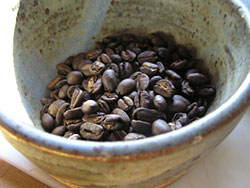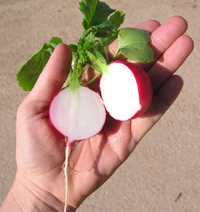 A fig for partridges and quails,
A fig for partridges and quails,
ye dainties I know nothing of ye;
But on the highest mount in Wales
Would choose in peace to drink my coffee.
~Jonathon Swift
Our coffee adventure began when we called up our local coffee roasters to order some of our favorite Mexican coffee and they said that they didn’t roast those beans anymore. So we decided to see what other coffee options were out there.
After reading a lot of info on the internet and tasting many coffees that were roasted by local companies we decided to search for green beans and roast our own.
Home roasting turns out to be a cost-effective luxury; you always get the optimum fresh cup that makes coffee drinking such a profound joy. Having fresh roasted coffee is also a benefit to your health – the roasted coffee you get in stores have been sitting for who knows how long and the beans go rancid after about a week… not good to ingest.
Here are a few tips and insights we have gathered through our coffee learning experience.
Our Favorite Coffee Bean
The beans we love are called Harar Longberry, named after a region where coffee arabica is indigenous and first domesticated, and comes from some of the highest grown bushes in the world (up to 2600m.).It’s one of the world’s most ancient commercially traded coffee, yet still grown and processed exactly as it was five hundred years ago when it first seduced the world. Harrar Longberry is known as the best highland grown Ethiopian Arabica coffee. It has a medium acidity, full body, and winey, gamey, berry flavors …as the roast gets darker, a chocolate flavor comes out.
The coffee bushes are allowed to grow wild and although it doesn’t say so on the sacks, no fertilizer or pesticides are used. The Harar coffee is hand/dry processed. This means that when the beans are ripe, they are picked by hand, dried in the sun and carried to market, where the dried fruit husks are removed by the millstone and the chaff winnowed from the beans by hand. Most commercial plantations use a water method of soaking the beans to loosen the husk and this makes the bean ferment, ultimately making the coffee less tasteful and healthy.
Coffee processing: Dry Vs Wet
The coffee cherry matures for about 5-6 months on the branch.
The cherry must be ripe when picked. At any given time a branch contains ripe and unripe fruit simultaneously. Good quality coffee is hand picked with continuous passes on the same trees.
Dry-process:
The whole ripe coffee cherries are laid out on patios to sun-dry. Then the seed is milled out of the cherry once the moisture content is down to about 12%. This simple ancient method produces a tastier and healthier coffee.
Wet-process:
First the beans are dumped in water tanks. Any overripe cherries, leaves, sticks etc float to the top and are skimmed off. Next the beans travel down a water slide to be de-skinned. Then the seeds, still covered with their pulp, go into tanks to ferment. Then they are once again sent down a water channel to remove the now soft pulp. Now the bean can be dried and packaged.
Roasting
Years ago we found a great home roaster: the Home Innovations Precision Roaster.
We drilled an extra large hole in the lid so we could insert a high temp thermometer to see precisely what temps we preferred for roasting. We found that our favorite roasts are Full City+ (454 f) and Vienna (465 f).
When our roaster finally died we bought Hearthware iRoast2 and it does a great job.
Brewing Methods
We highly recommend using a French press. If you don’t have one, the next best brewer would be either the espresso pot (moka pot) or to make cowboy coffee.
French Press
It’s a cylindrical glass pot that has a plunger attached to the lid so that when you push down on the top of the plunger, it forces a fine wire mesh through to the bottom. You put the ground coffee into the pot, add hot water, and cover with the lid. After the coffee steeps for two minutes, push the plunger down, forcing the grounds to the bottom of the pot while the brewed coffee remains above.
For the French Press, you want a grind that is as fine as possible without letting sediment past the screen. This usually works out to be a tad coarser than filter-drip grind.
Cowboy Coffee
It’s just like the French press method, but without the press. In a pot, boil your water, shut off the heat, take a long breath (or whistle for the cows) and then add the coffee grounds (you may need to add slightly more grounds than usual). After two minutes, pour through a fine strainer and drink.
* French Press and Cowboy coffee methods leave some sediment in the final cup which is unattractive to some folks, but the pay off is you get a much more flavor. If you really dislike sediment, pour the brew through a fine strainer before drinking.
Espresso/Moka Pot
These stovetop brewers produce a dense cup that’s something between espresso and Turkish coffee. The grounds are put into a filter between the lower chamber (that you fill with water) and the upper chamber that will contain the finished beverage after brewing. Since the water is forced through the cake of coffee by pressure, the process bears more resemblance to espresso extraction than gravity-based (infusion) brewing. Use a low to medium flame, which also helps avoid blackening the brewer itself. If you invest in one of these, be sure it is made of stainless steel.
Don’t be a Drip
PLEASE DON’T !!!…
put the coffee in a regular auto-drip coffee maker; due to it’s inability to get the water to the correct brewing temperature (195-200 degrees), it will obliterate the multi-layered flavors that make this kind of coffee a special treat.
Test the Water
We are lucky to have ultra clean well water that’s on the hard side because it makes for an ideal brew. Soft water can make coffee taste dull, muting the good bright flavors in a cup. So, its always safe to use bottled spring water if you have soft water at home or when you are traveling.
To prevent scalding the grounds, boiling water should never come in contact with fresh ground coffee. The ideal brewing temperature, regardless of method, is about 195 – 200 degrees F.
Grounds for Joy
2 heaping tablespoons of ground coffee for each 10 to 12 oz. of water (for each regular mug). This is our preferred measurement, you may find that you like your coffee stronger or weaker than this.
* There is a standard coffee measure scoop used by the Specialty Coffee Association. It is 1 Level scoop that approximates 7.25 grams coffee. Use 1 Scoop per 6-8 oz water.
Drinking Tips
Fresh brewed coffee tastes best within the first 10 minutes.
As you can tell, we really love our coffee. If you are interested in home roasting, We’d be happy to relay any tips we learned through our own roasting experiments.
Happy day to you.
We hope you will have a moment to sit quietly outside and enjoy this special coffee treat.
More Info
Sweet Maria’s
We order beans and bought our Roasters from Sweet Maria’s. They also supply roasters, grinders and all sorts of coffee paraphernalia as well as provide valuable info for coffee lovers and home roasters.
Pictorial Guide to the Roast Process
Tweaking Coffee’s Flavor Chemistry
A morning without coffee is like sleep. ~Author Unknown

 We're eclectic organic gardeners – growing, tinkering, writing, arting, soldering, and eating in the Arizona Sonoran Desert.
We're eclectic organic gardeners – growing, tinkering, writing, arting, soldering, and eating in the Arizona Sonoran Desert.






Recent Comments